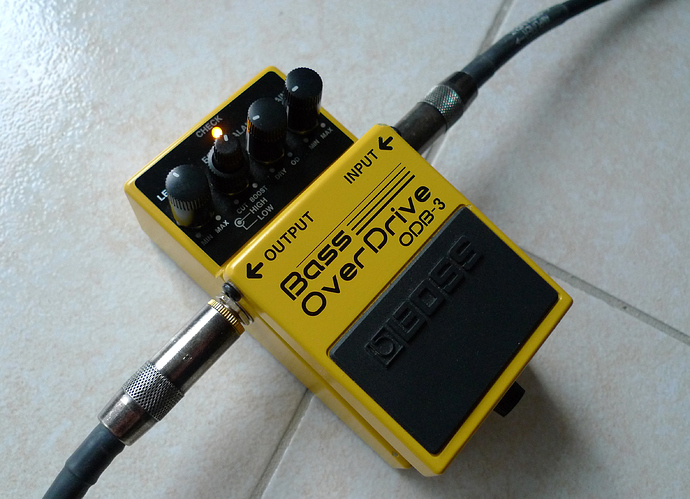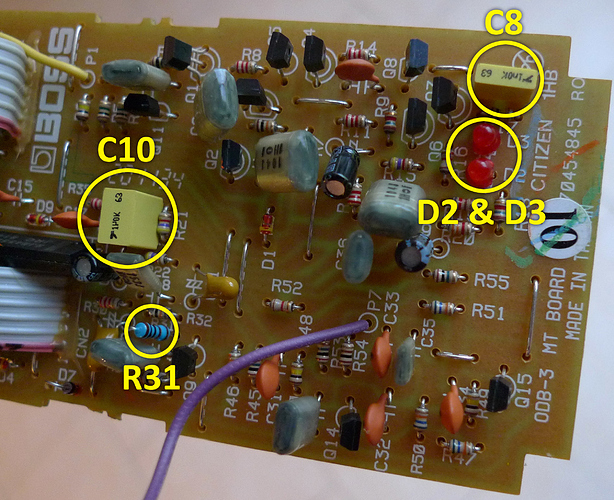Hey all 
 so, this thread is a tutorial about the Boss ODB-3 mod, with some comments from my different tests.
so, this thread is a tutorial about the Boss ODB-3 mod, with some comments from my different tests.
First, here is the beast :
About the ODB-3 and the mod …
This the only Boss overdrive pedal, and it seems everybody is ok to say that it’s not a good one. In my opinion, the biggest problem with this overdrive is that … it’s not an overdrive. It sounds tiny, like an overdub of a thin tiny treebly layer stacked over the clean tone. Plus it’s noisy as hell (I assume hell must be noisy).
There is a common mod on the internet for this pedal. I tried various things but I ended up with this common mod, simply because it works well.
So I want to be very clear about the fact that, despite my tests, I’m not the inventor of this mod ; I only explain and comment an existing mod.
What to expect with this mod ?
Here is a quick sum up of what you will obtain with this pedal, after doing the mod :
- it’s really an overdrive
- sounds full and warm
- very transparent, doesn’t really add any color (except with the 2-band EQ if you want), just a transparent gain that is added to your bass tone
- way less noisy than the original
- the overdriven signal blends way better with the original tone than the original
- can be tweaked with the diodes option (more about this later in this post)
- … a very good bass overdrive overall !
but :
- the pedal remains very sensitive to the PSU quality ; it sounds good with a battery and a good quality PSU, but it’s very likely to bring some “hiss” and other PSU noises
- the pots are not very progressive
- the EQ has too much amplitude considering the tiny knobs size, in my opinion
- sounds fuzzy (not necessarily in a good way) when the gain is cranked up
Overall, with my gear (Precision Bass / SVT-VR model) it makes me think about some kind of vintage version of the Darkglass tone.
Let’s do the mod
The mod is very simple, of course it requires a soldering iron and the matching skills, but there are only a few components to change :
- R31 : replace with a 1k resistor (original value : 3.3k)
- C10 : replace with a 1μF or 2.2μF non-polarized capacitor (original value : 33nF = .033μF)
- C8 : replace with a 1nF = .001μF capacitor (original value : 300pF)
- D2 & D3 : optionnal tweaks (more about this later)
When the pedal is open, here is where to find those components :
and that’s it. after you changed those components, you just have to close the pedal and go try it.
Diodes options
The D2 and D3 diodes are clipping diodes, they force the signal to clip with a relatively low actual gain. that’s a good way to design an overdrive, and the diodes play an important role in the final tone as they actually “create” the clipping.
LEDs (like on the stock ODB-3) bring some kind of smooth, natural clipping but still pretty agressive. changing D2 & D3 with 1N4148 will bring more headroom, a little bit warmer tone overall but still something pretty close to the LEDs. 1N34A are germanium diodes, they will sound much warmer, more “vintage”, but less precise and accurate.
Of course you can try other diodes, like 1N4007 or Schottky diodes. The general idea is that you want each diode in opposite polarity to clip the two opposite phases of the signal. But you can mix diodes (like one 1N34A and one 1N4148), or you can even have one diode to replace one LED and replace the other one with tho diodes in series. A lot of possibilities.
I myself tried a lot of things, and finally decided to keep the red LEDs, because I wanted to keep that agressive clicky metallic edge. I found that 1N4148 were not very interesting, and 1N34A sounded very good if a more “vintage” tone is what you’re looking for.







